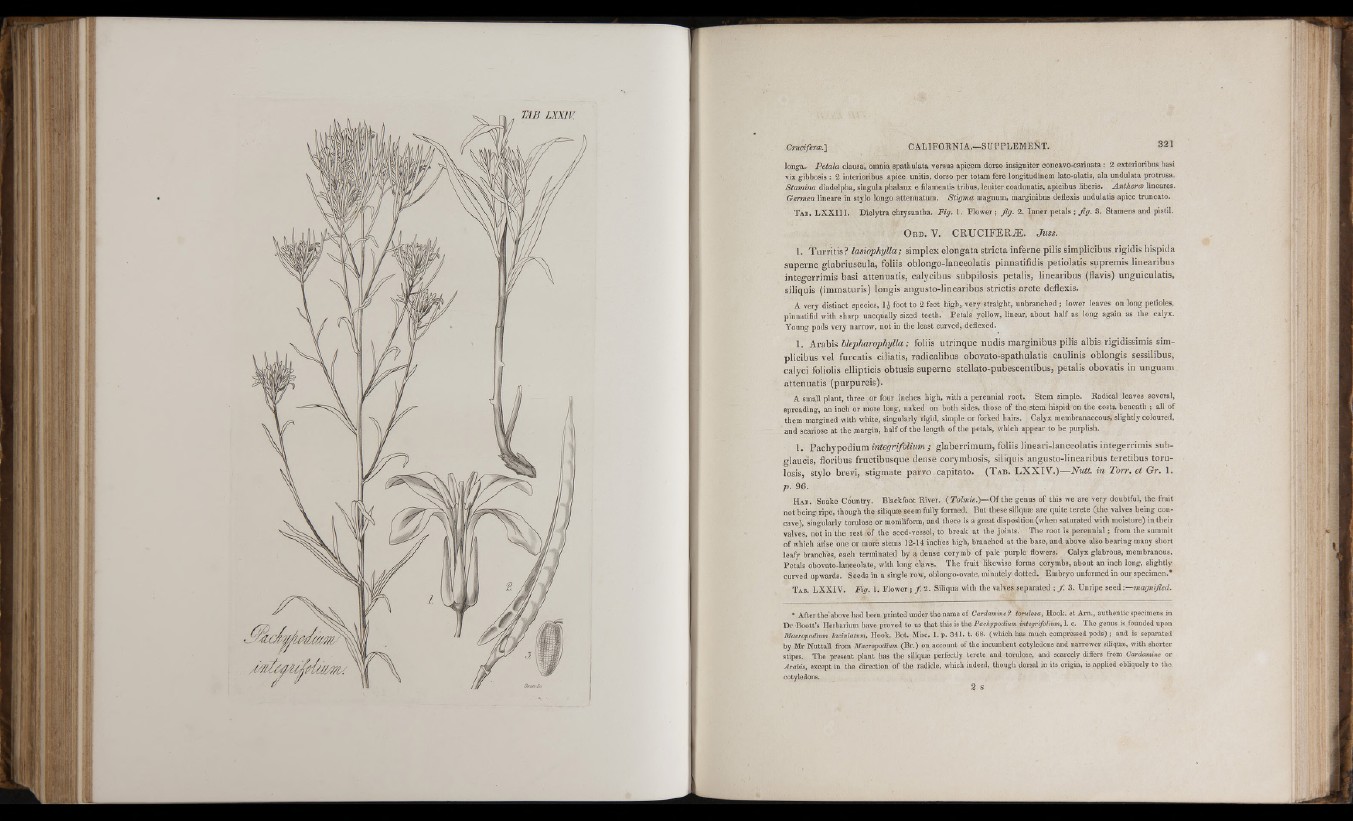
tab LXXB ’
J:
longa. Petala clausa, omnia spatlmlata versus apicem dorso insigniter concavo-carinata : 2 exterioribus basi
vix gibbosis : 2 interioribus apice unitis, dorso per totam fere longitudinem lato-alatis, ala undulata protrusa.
Stamina diadelpha, singula phalanx e filamentis tribus, leniter coadunatis, apicibus liberis. Antheræ lineares.
Germen lineare in stylo longo attenuatum. Stigma magnum, marginibus deflexis undulatis apice truncato.
T a b. L X X III. Dielytra chrysantha. Fig. 1. Flower ; Jig. 2 . Inner petals ; Jig. S . Stamens and pistil.
O r d . V. C R U C IF E R Æ . Juss.
1. T u rritis ? lasiophylla; simplex elongata stricta inferne pilis simplicibus rigidis hispida
superne glabriuscula, foliis oblongo-lanceolatis pinnatifidis petiolatis supremis linearibus
integerrimis basi attenuatis, calycibus subpilosis petalis, linearibus (flavis) unguiculatis,
siliquis (immaturis) longis angusto-Iinearibus strictis arcte deflexis.
A very distinct species, 1§ foot to 2 feet high, very straight, unbranched ; lower leaves on long petioles,
pinnatifid with sharp unequally sized teeth. Petals yellow, linear, about half as long again as tbe calyx.
Young pods very narrow, not in the least curved, deflexed.
1. Arabis blepharopkylla ; foliis u trin q u e nudis marginibus pilis albis rigidissimis simplicibus
vel furcatis ciliatis, radicalibus obovato-spathulatis caulinis oblongis sessilibus,
calyci foliolis ellipticis obtusis superne stellato-pubescentibus, petalis obovatis in unguam
a ttenuatis (purpureis).
A small plant, three or four inches high, with a perennial root. Stem simple. Radical leaves several,
spreading, an inch or more long, naked on both sides, those of the stem hispid on the costa beneath ; all of
them margined with white, singularly rigid, simple or forked hairs. Calyx membranaceous, slightly coloured,
and scariose at the margin, half of the length of the petals, which appear to be purplish.
1. Pacbypodium integrifolium ; glaberrimum, folüs lineari-lanceolatis integerrimis sub-
glaucis, floribus fructibusque dense corymbosis, siliquis angnsto-linearibus teretibus to ru losis,
stylo brevi, stigmate parvo capitato. ( T a b . L X X IV .)—Nutt, in Torr. et Gr. 1.
p. 96.
H ab. Snake Country. Blackfoot River. {T o lm ie .)-O i the genus of this we are very doubtful, the fruit
not being ripe, though the siliquæ seem fully formed. But these siliquæ are quite terete (the valves being concave),
singularly torulose or moniliform, and there is a great disposition (when saturated with moisture) in their
valves, not in the rest of the seed-vessel, to break at the joints. The root is perennial ; from the summit
of which arise one or more stems 12-U inches high, branched at the base, and above also bearing many short
leafy branches, each terminated by a dense corymb of pale purple flowers. Calyx glabrous, membranous.
Petals obovato-lanceolate, with long claws. The fruit likewise forms corymbs, about an inch long, slightly
curved upwards. Seeds in a single row, oblongo-ovate, minutely dotted. Embryo unformed in our specimen.'
Tab. LXXIV. Fig. I. Flower ; f . 2. Siliqua with the valves separated ; f . 3. Unripe seed -.—magnified.
' After tho'above had been printed under the name of Cardamine f torulosa, Hook, et Arn., authentic specimens in
Dr Boott’s Herbarium have proved to us that this is the Pachypodium integrifolium, 1. c. Tiie genus is founded upon
MacTopodiwm ladniatum. Hook. Bot. Misc. l.p . 341. t. 68. (which has much compressed pods) ; and is separated
by Mr Nuttall from Macropodium (Br.) on account of the iucumbeut cotyledons and narrower siliquæ, with shorter
stipes. Tho present plant has the siliquæ perfectly terete aud torulose, aud scarcely differs from Cardamine or
Arabis, except iu the direction of tho radicle, which indeed, though doreal in its origin, is applied obliquely to the
cotyledons.